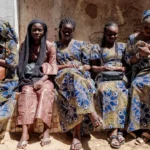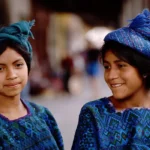Kenya, a land of breathtaking landscapes and vibrant cultures, boasts a rich tapestry of traditional clothing that reflects the nation’s diverse heritage.
Home to more than 40 ethnic groups, Kenya’s traditional attire is a fascinating blend of symbolism, craftsmanship, and identity. From the iconic Shúkà of the Maasai to the intricately beaded jewelry of the Samburu, each garment and accessory tells a unique story of community, history, and pride.
In this article, we explore the origins, regional variations, and cultural significance of traditional Kenyan clothing, providing an in-depth look at the attire that defines this East African nation.
Historical Roots of Kenyan Traditional Clothing
Indigenous Influence
Before the arrival of colonial powers, Kenyan communities relied on natural resources to create clothing suited to their environment. Early clothing included:
See also Traditional Clothing in Senegal: A Vibrant Expression of Culture and Heritage
Traditional Clothing in Senegal: A Vibrant Expression of Culture and Heritage
- Animal Skins and Hides: Used by communities like the Maasai and Turkana for warmth and protection.
- Plant-Based Fibers: Raffia and sisal were woven into mats, belts, and skirts.
- Natural Dyes: Derived from plants, clay, and ash to add vibrant colors to fabrics.
Colonial and Post-Colonial Influence
The colonial era introduced imported fabrics like cotton, silk, and European-style tailoring, which blended with traditional designs. After independence, there was a renewed emphasis on preserving cultural heritage through clothing, leading to a resurgence of traditional attire during festivals, ceremonies, and national celebrations.
Key Elements of Traditional Kenyan Clothing
For Women
- Kanga:
- 🧣 A rectangular piece of cloth, often brightly colored and adorned with Swahili proverbs.
- Worn as a wraparound skirt, headscarf, or baby carrier, the Kanga serves both practical and symbolic purposes.
- Kitambi:
- 👗 A long, flowing dress worn during special occasions, often paired with a headscarf.
- Popular among the Swahili people, it incorporates intricate embroidery and lace detailing.
- Beaded Jewelry:
- 💎 Necklaces, bracelets, and earrings are crafted from colorful beads, symbolizing marital status, age, and social standing.
- Shúkà Wraps:
- 🧥 Adopted by some women in pastoralist communities, this vibrant cloth serves as both clothing and bedding.
For Men
- Shúkà:
- 🦁 The iconic red, blue, or checkered cloth worn by the Maasai men.
- Often draped over the shoulders or tied around the waist, it serves as protection from the elements and predators.
- Kitenge:
- 🧵 A brightly patterned fabric used to make shirts, trousers, and jackets.
- Worn for semi-formal occasions, it’s a modern adaptation of traditional attire.
- Headgear:
- 🎩 Men in some communities wear headbands or caps adorned with beads or feathers, signifying rank or spiritual significance.
- Beaded Belts and Anklets:
- Accessorized by pastoralist men, these items highlight traditional craftsmanship and social status.
Regional Variations in Kenyan Traditional Clothing
Maasai (Southern Kenya)
The Maasai are perhaps the most internationally recognized Kenyan community due to their vibrant clothing and jewelry:
- Shúkà: Known as the “African blanket,” this fabric is typically red, symbolizing bravery and strength.
- Beaded Jewelry: Women and men wear elaborate necklaces, bracelets, and earrings, each color carrying a specific meaning (e.g., white for purity, red for courage).
- Ochre Body Paint: Used as a cosmetic and sunscreen, particularly by warriors.
Samburu (North-Central Kenya)
Similar to the Maasai, the Samburu are known for their colorful attire and accessories:
- Beaded Necklaces: Women wear heavy, layered necklaces as a sign of beauty and social status.
- Cowrie Shell Adornments: Added to clothing and jewelry to symbolize wealth.
- Vibrant Wraps: Men wear bright cloths draped around the body, often accessorized with spears or sticks.
Swahili Coast (Eastern Kenya)
The Swahili people, influenced by Arab and Indian traders, showcase a unique blend of African and Islamic styles:
See also Traditional Clothing in Guatemala: A Vibrant Cultural Legacy
Traditional Clothing in Guatemala: A Vibrant Cultural Legacy
- Kanzu: A white, ankle-length robe worn by men, often paired with a cap called a kofia.
- Buibui: A black cloak worn by women for modesty, often paired with a colorful kanga underneath.
- Intricate Embroidery: Seen on both men’s and women’s clothing, reflecting coastal artistry.
Turkana (Northern Kenya)
The Turkana people’s clothing is designed to suit their arid environment:
- Animal Skin Wraps: Dyed with natural pigments for durability and style.
- Metallic Jewelry: Crafted from copper and brass, worn around the neck and arms.
- Headgear: Men often wear elaborate headpieces adorned with ostrich feathers.
Kikuyu (Central Kenya)
The Kikuyu people favor simple yet elegant attire:
- Leather Garments: Traditionally made from goat or cowhide, softened and dyed for comfort.
- Modern Adaptations: Kikuyu women often wear patterned kitenge dresses, blending tradition with contemporary fashion.
- Ngatha: A headscarf or shawl, worn during ceremonies.
Cultural Significance of Traditional Kenyan Clothing
Symbolism and Identity
Traditional clothing in Kenya serves as a marker of ethnic identity, marital status, and age. For example:
- Red Shúkà of the Maasai: Represents courage and a connection to the land.
- Beaded Necklaces: In many communities, the number of necklaces worn by women indicates their social standing.
Craftsmanship and Artistry
Kenyan traditional attire is celebrated for its intricate craftsmanship:
- Beadwork: An integral part of Kenyan culture, used to create jewelry, belts, and headbands.
- Weaving and Dyeing: Textiles like Kanga and Kitenge showcase vibrant patterns and bold colors.
Role in Ceremonies
Traditional clothing plays a central role in Kenyan rituals and celebrations:
- Weddings: Brides wear elaborate jewelry and colorful wraps, while grooms often don tailored Kitenge or Kanzu outfits.
- Coming-of-Age Ceremonies: Young men and women wear symbolic attire during initiation rites, signifying their transition to adulthood.
Challenges and Modern Adaptations
Globalization and Urbanization
As Western-style clothing becomes more prevalent, traditional attire faces challenges in maintaining its relevance. However, many Kenyans continue to wear traditional clothing during special occasions, ensuring its survival.
Fashion Fusion
Contemporary Kenyan designers are blending traditional elements with modern styles, creating:
- Ankara Gowns: Incorporating vibrant Kitenge fabrics into Western-style dresses.
- Beaded Sandals: A modern twist on traditional beadwork, popular among urban youth.
- Casual Shúkà Adaptations: Used as scarves, blankets, or capes in daily life.
Preserving Kenya’s Cultural Heritage Through Clothing
Efforts to protect and celebrate traditional Kenyan attire include:
- Cultural Festivals: Events like the Lamu Cultural Festival and Maasai Mara Cultural Week showcase traditional clothing and jewelry.
- Educational Programs: Schools and workshops teach traditional weaving, beadwork, and tailoring techniques.
- Global Recognition: Kenyan designs and textiles are gaining international attention, promoting cultural pride.
The Enduring Legacy of Kenyan Traditional Clothing
Traditional clothing in Kenya is more than just fabric and beads; it is a vivid expression of the nation’s cultural richness and resilience. Whether it’s the bold Shúkà of the Maasai, the intricate beadwork of the Samburu, or the elegant Kanga of the Swahili, each piece reflects the history, identity, and artistry of Kenya’s people.
As Kenyans continue to honor their heritage through attire, these garments remain a timeless symbol of unity, diversity, and pride.